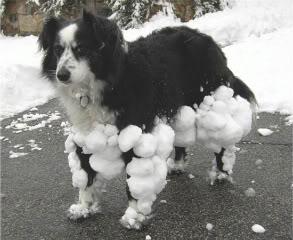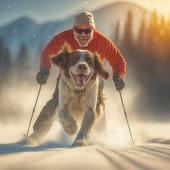Hampered Hounds
Dealing with lameness in outdoor dogs.
The most common cause of lameness in a healthy outdoor dog is an injury to the foot. Carefully examine the nails, webs, and pads of your dog’s feet if limping occurs with no other obvious cause.
Pad, Toe, and Web Cuts
Causes: Imbedded glass, cuts inflicted by sharp objects, snow or ice, crushing injuries, loose rocks, tender under-conditioned feet, overgrown toenails.
Signs: Sudden onset of limping, sometimes preceded by a yelp in rough going. Dog often repeatedly stops his activity to lick or bite at a foot. Bloody footprints are sometimes to first indication of an injury. Cuts or lacerations of the pads or toe webbing are common. Some bleed profusely. Cut pads gape open and appear unsightly, sometimes looking quite unsightly with a bulging, meaty appearance.
Prevention: Proper conditioning, avoid exercise in areas where trauma is likely.
Treatment: Cleaning and wrapping (with cotton between the toes) controls bleeding and prevents further trauma and infection. Cold water rinses clean the area and offers pain relief. Booties can be improvised from stockings or a variety of other materials. Be careful to avoid cutting off circulation when fastening and securing booties or wraps. Moisture and motion can cause booties to tighten, resulting in loss of circulation to the injured digits. For feet tender from overexercise in rough-going situations, rest your dog when possible, and minimize further travel. Surgical glue (Nexaband) can be applied to tender pads to provide durable protection.
Blistered Pads
Causes: Dogs not adequately conditioned for extensive foot travel, dogs packed too heavily or exercised too long. Foot burns from fires, stoves, or cookware.
Signs: Limping after unaccustomed exercise over rough terrain.
Prevention: Gradual conditioning toughens pads, making them resistant to wear-and-tear injuries while conditioning the dog. Properly fitted booties or wraps protect injured feet, and can also be used preventively. Do not overburden dogs with excessive weight if they are expected to carry packs. Applying certain substances to the feet, such as Preparation H, surgical glue, and formaldehyde, is seldom adequately effective in toughening pads up. Proper conditioning is the preferred method, as it also conditions the muscles and cardiovascular system, and it avoids the possibility of the dog licking off preparations that can be toxic, upsetting to the stomach, and irritating to the mouth and tongue.
Treatment: Clean the affected pads, removing any attached or penetrating materials. Soak the paws in water with Epsom salts (a handful of salts to one quart of water) or, if feasible, stand the dog in a cold stream to relieve the pain and swelling. Wrap the affected feet for protection if further travel is necessary (discontinuing exercise is preferred). Surgical glue (Nexaband) can be applied lightly to abraded, cut, or worn-though pads allowing it to dry before further exercise. The glue forms a protective coating but has its limitations. Vulnerable, foot-sore dogs should be taken to a veterinarian beforehand to obtain advice regarding care and prevention.
Fractures—Broken Leg
Besides the risk of infection from a compound fracture, as discussed below, fractures can result in other health problems. When bones are broken in two, clots occasionally dislodge, or fatty marrow enters the bloodstream, causing circulation disorders involving the brain, lungs, heart, and other vital organs. It is thus important that you get your dog to a veterinarian if you think he has broken a bone.
Causes: Trauma.
Signs: Dog refuses to bear weight on the leg, or carries the limb. The leg may obviously be dangling, floppy, or displaced. If the skin is broken, or blood is present near the fracture site, the fracture is considered compound, and very serious because of potential bone infection which can be life-threatening. Before you panic, make sure a broken toenail is not causing the lameness, rather than a fracture. A dog will not bear weight on the affected leg if a bone is broken.
Prevention: Care, obedience, restraint, and vigilance.
Treatment: Leash and calm your dog. Fractures are painful, especially with movement. A muzzle may be needed for your safety. To determine the location and extent of a fracture, compare the affected limb with the opposite, unaffected limb. Cracked or chipped bones do not pose the serious threat that bones broken in two do.
Clean and flush any wounds with sterile disinfectant solution. Use care to avoid forcing debris or hair deeper into the wound. Stabilize the dog, then stabilize the leg. Monitor and treat your dog for shock and internal injuries that can accompany fractures.
Only lower leg fractures (those below the stomach line in a standing dog) can be effectively splinted in the field. Fractures of upper leg bones (bones above dog’s stomach line, the humerus in the front leg, the femur in the hind) should not be splinted. If the dog can efficiently carry the injured leg, wrapping and splinting may not be needed. Wrap and splint the lower leg bones that are obviously displaced.
Your dog may need to be carried. A dog is generally best held chest to chest, with one of your arms snugly under and around his neck and shoulders, and the other behind his upper hind legs, tucking them under the pelvis. Different transport strategies, depending on the severity and location of the fracture or fractures, may need to be employed if this method causes undo pain or fails to effectively stabilize the broken leg.
Splints are generally used to stabilize fractures of the lower legs. Effective splinting immobilizes the joint above and below the fracture. If the joint above the break cannot be at least partially immobilized, splinting may be counterproductive. The objectives of a splint are to stabilize the fracture and align the bones. Splints that add weight below the fracture and do not stabilize the joint above the fracture have a pendulum effect and do more harm than good.
One of the lightest and most easily applied splint materials is a roll of foam-padded sheet aluminum (SAM Splint). Cut the material to size with scissors and then mold it to fit the contour of the injured leg. After properly fitting the splint material, pad the leg with synthetic cast padding and secure the splint with wrap. (Vetwrap is easy to use and holds well. Take care that you do not apply it too tightly.)
Dislocations
The hip, shoulder, and elbow are the most frequently dislocated joints, but any joints, including the spinal and neck joints, can be dislocated. All require veterinary attention, except the unusual case that somehow “pops” itself back in.
Dislocations are easily confused with fractures and may in fact be associated with a fracture. We are in the realm of veterinary medicine here. Get your dog to a doctor with a reasonable urgency. The sooner a dislocated joint is returned to its socket the less likely the dislocation is to recur. General anesthesia is usually required to achieve the necessary muscle relaxation to reduce (replace the joint in its socket) the dislocation.
Causes: Twisting trauma to a joint, often from a blow, kick, or fall.
Signs: Limbs abnormally bent at the joint and carried in a crooked fashion; pain may or may not be present.
Prevention: Proper conditioning, restraint and control of your dog in dangerous situations. Take care to avoid unstable travel on steep slopes, rocky riverbeds, and heavily timbered terrain.
Treatment: Reduction requires veterinary anesthesia and specialized manipulation. Back, neck, and joint dislocations cannot be easily differentiated from fractures; all require careful transport to veterinary care. With leg joint dislocations, as with some fractures, the dog may be able to carry his leg through smooth terrain. When nerve damage is present, rendering the limb limp with dragging, you may want to secure the affected limb to the torso with wraps to help the dog travel if the situation so warrants. Dislocations are usually not amenable to splinting.
As for popping a joint back into place in the field, a thorough knowledge of canine anatomy and physiology are a prerequisite. Understand that fracture may complicate the condition. First do no harm.
This article is an excerpt from First Aid for the Active Dog, published by Alpine Publications.











